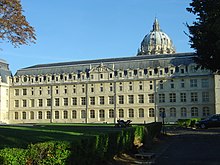Val-de-Grâce
Val-de-Grâce (German: "Valley of Grace") is an important, partly historical building complex in the 5th arrondissement in Paris , which consists of a former royal convent and the associated church of Notre-Dame du Val-de-Grâce from the 17th century Century as well as of contemporary buildings that currently house a military hospital , the Hôpital d'instruction des armées du Val-de-Grâce , or HIA Val-de-Grâce .
The abbey
The abbey was founded in 1621 by the French Queen Anna of Austria to house nuns from the Val-de-Grâce de Bièvre monastery - and to receive religious support for the hoped-for birth of an heir to the throne, which was still a long time coming when the future Louis XIV was born.
After the death of her husband Louis XIII. In 1645 Anna commissioned François Mansart to add a church (in the middle) and a palace (left) to the convent (which is on the right as seen from the forecourt), in which she wanted to live herself. Mansart was recalled a year later, so only the church was built according to his plans. After several changes of master builder - Jacques Lemercier , Pierre Le Muet and Gabriel Leduc followed Mansart - the church was completed in 1667.
Anna von Österreich had died the year before in her apartment in the convent.
During the French Revolution , the royal insignia was erased and the ensemble was rededicated as a military hospital.
The hospital
During the revolution (1789–1799) the ensemble was rededicated as a military hospital. The École du Val-de-Grâce was created , where Félix Hippolyte Larrey, the son of Dominique Jean Larrey , studied from 1828 and was given the chair of surgery in 1841. In addition, there was the École d'application de médecine militaire in 1850 ; In 1993 it became the École d'application du Service de santé des armées and thus the first university hospital for the French military . Contrary to a common rumor in the past, there is no personally reserved hospital room for either the President or the Prime Minister . VIP rooms do exist, but they are not personal. Two former French Prime Ministers, Raymond Barre and Pierre Messmer , spent their final days in hospital.
literature
- Paris . Editions du patrimoine, Paris 2008, ISBN 2-7577-0024-3 .
- Jean-Pierre Babelon: François Mansart . Editions Gallimard, Paris 1998, ISBN 2-0701-1592-5 .
- André Chastel: L'art français . Volume 3, Flammarion, Paris 1995, ISBN 2-0801-0190-0 .
- Aline Dumoulin, Alexandra Ardisson, Jérôme Maingard, Murielle Antonello: Paris d'Église en Église . Éditions Massin, Paris 2008, ISBN 978-2-7072-0583-4 .
- Alexandre Gady: La Montagne Sainte-Geneviève et le Quartier Latin . Editions Hoëbeke, Paris 1998, ISBN 2-8423-0067-X .
- Jean-Marie Pérouse de Montclos: Le guide du Patrimoine . Paris 1994, ISBN 2-0101-6812-7 .
- Jean-Marie Pérouse de Montclos: Histoire de l'architecture française . Volume 2, Editions du Patrimoine, Mengès / Paris 1999, ISBN 2-8562-0374-4 .
Web links
- Hôpital militaire du Val-de-Grâce at Structurae (French)
- Hôpital d'instruction des armées du Val-de-Grâce on the website of the French Ministry of Defense (French)
- École du Val-de-Grâce (French)
- Ancienne Abbaye Royale du Val de Grace on the Paris Tourist Office website (French)
- Musée du Service de santé des armées au Val de Grâce on the Paris Tourist Office website (French)
- Eglise Royale du Val de Grâce on the Paris Tourist Office website (French)
Individual evidence
- ↑ Barbara I. Tshisuaka: Larrey, Félix Hippolyte Baron. In: Werner E. Gerabek , Bernhard D. Haage, Gundolf Keil , Wolfgang Wegner (eds.): Enzyklopädie Medizingeschichte. De Gruyter, Berlin / New York 2005, ISBN 3-11-015714-4 , p. 826.
Coordinates: 48 ° 50 ′ 23 " N , 2 ° 20 ′ 33" E



